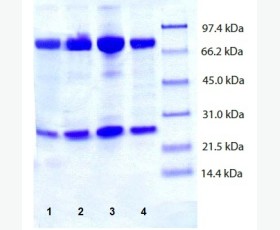Recombinant Human Chloride Intracellular Channel Protein 3/CLIC3
| Product name: | Recombinant Human Chloride Intracellular Channel Protein 3/CLIC3 |
| Source: | E. coli |
| Purity: | Greater than 95% as determined by reducing SDS-PAGE. |
| Buffer Formulation: | Supplied as a 0.2 μm filtered solution of 10mM Tris, 0.1%Triton100, pH 8.0. |
| Applications: | Applications:SDS-PAGE; WB; ELISA; IP. |
| Storage: | Avoid repeated freeze/thaw cycles. Store at 2-8 oC for one month. Aliquot and store at -80 oC for 12 months. |
| UOM: | 100ug/50ug/200ug/1mg/1g |
| Source | E. coli |
| Description | Recombinant Human CLIC3 is produced by our E.coli expression system and the target gene encoding Met1-Arg236 is expressed with a 6His tag at the C-terminus. |
| Names | Chloride intracellular channel protein 3, CLIC3, |
| Accession # | O95833 |
| Formulation | Supplied as a 0.2 μm filtered solution of 10mM Tris, 0.1%Triton100, pH 8.0. |
| Shipping |
The product is shipped on dry ice/ice packs. |
| Storage |
Store at < -20°C, stable for 6 months after receipt. Please minimize freeze-thaw cycles. |
| Purity |
Greater than 95% as determined by reducing SDS-PAGE. |
| Endotoxin | Less than 0.1 ng/µg (1 IEU/µg) as determined by LAL test. |
| Amino Acid Sequence |
MAETKLQLFVKASEDGESVGHCPSCQRLFMVLLLKGVPFTLTTVDTRRSPDVLKDFAPGSQLPIL LYDSDAKTDTLQIEDFLEETLGPPDFPSLAPRYRESNTAGNDVFHKFSAFIKNPVPAQDEALYQQ LLRALARLDSYLRAPLEHELAGEPQLRESRRRFLDGDRLTLADCSLLPKLHIVDTVCAHFRQAPI PAELRGVRRYLDSAMQEKEFKYTCPHSAEILAAYRPAVHPRLEHHHHHH
|
| Background | Chloride intracellular channel protein 3 (CLIC3) is encoded by the CLIC3 gene. CLIC3 is a single-pass membrane protein which belongs to the chloride channel CLIC family. It contains one GST C-terminal domain and one GST N-terminal domain. Chloride intracellular channel protein 3 high expressed in the placental, lung and heart, low expressed in skeletal muscle, kidney and pancreas. Chloride intracellular channel protein 3 can insert into membranes and forms chloride ion channels, may participate in cellular growth control. |














